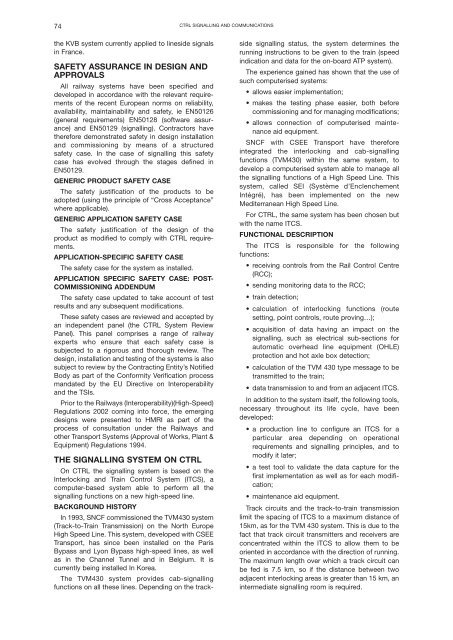Proceedings 2002/2003 - IRSE
Proceedings 2002/2003 - IRSE
Proceedings 2002/2003 - IRSE
Create successful ePaper yourself
Turn your PDF publications into a flip-book with our unique Google optimized e-Paper software.
74 CTRL SIGNALLING AND COMMUNICATIONS<br />
the KVB system currently applied to lineside signals<br />
in France.<br />
SAFETY ASSURANCE IN DESIGN AND<br />
APPROVALS<br />
All railway systems have been specified and<br />
developed in accordance with the relevant requirements<br />
of the recent European norms on reliability,<br />
availability, maintainability and safety, ie EN50126<br />
(general requirements) EN50128 (software assurance)<br />
and EN50129 (signalling). Contractors have<br />
therefore demonstrated safety in design installation<br />
and commissioning by means of a structured<br />
safety case. In the case of signalling this safety<br />
case has evolved through the stages defined in<br />
EN50129.<br />
GENERIC PRODUCT SAFETY CASE<br />
The safety justification of the products to be<br />
adopted (using the principle of “Cross Acceptance”<br />
where applicable).<br />
GENERIC APPLICATION SAFETY CASE<br />
The safety justification of the design of the<br />
product as modified to comply with CTRL requirements.<br />
APPLICATION-SPECIFIC SAFETY CASE<br />
The safety case for the system as installed.<br />
APPLICATION SPECIFIC SAFETY CASE: POST-<br />
COMMISSIONING ADDENDUM<br />
The safety case updated to take account of test<br />
results and any subsequent modifications.<br />
These safety cases are reviewed and accepted by<br />
an independent panel (the CTRL System Review<br />
Panel). This panel comprises a range of railway<br />
experts who ensure that each safety case is<br />
subjected to a rigorous and thorough review. The<br />
design, installation and testing of the systems is also<br />
subject to review by the Contracting Entity’s Notified<br />
Body as part of the Conformity Verification process<br />
mandated by the EU Directive on Interoperability<br />
and the TSIs.<br />
Prior to the Railways (Interoperability)(High-Speed)<br />
Regulations <strong>2002</strong> coming into force, the emerging<br />
designs were presented to HMRI as part of the<br />
process of consultation under the Railways and<br />
other Transport Systems (Approval of Works, Plant &<br />
Equipment) Regulations 1994.<br />
THE SIGNALLING SYSTEM ON CTRL<br />
On CTRL the signalling system is based on the<br />
Interlocking and Train Control System (ITCS), a<br />
computer-based system able to perform all the<br />
signalling functions on a new high-speed line.<br />
BACKGROUND HISTORY<br />
In 1993, SNCF commissioned the TVM430 system<br />
(Track-to-Train Transmission) on the North Europe<br />
High Speed Line. This system, developed with CSEE<br />
Transport, has since been installed on the Paris<br />
Bypass and Lyon Bypass high-speed lines, as well<br />
as in the Channel Tunnel and in Belgium. It is<br />
currently being installed In Korea.<br />
The TVM430 system provides cab-signalling<br />
functions on all these lines. Depending on the trackside<br />
signalling status, the system determines the<br />
running instructions to be given to the train (speed<br />
indication and data for the on-board ATP system).<br />
The experience gained has shown that the use of<br />
such computerised systems:<br />
• allows easier implementation;<br />
• makes the testing phase easier, both before<br />
commissioning and for managing modifications;<br />
• allows connection of computerised maintenance<br />
aid equipment.<br />
SNCF with CSEE Transport have therefore<br />
integrated the interlocking and cab-signalling<br />
functions (TVM430) within the same system, to<br />
develop a computerised system able to manage all<br />
the signalling functions of a High Speed Line. This<br />
system, called SEI (Système d’Enclenchement<br />
Intégré), has been implemented on the new<br />
Mediterranean High Speed Line.<br />
For CTRL, the same system has been chosen but<br />
with the name ITCS.<br />
FUNCTIONAL DESCRIPTION<br />
The ITCS is responsible for the following<br />
functions:<br />
• receiving controls from the Rail Control Centre<br />
(RCC);<br />
• sending monitoring data to the RCC;<br />
• train detection;<br />
• calculation of interlocking functions (route<br />
setting, point controls, route proving…);<br />
• acquisition of data having an impact on the<br />
signalling, such as electrical sub-sections for<br />
automatic overhead line equipment (OHLE)<br />
protection and hot axle box detection;<br />
• calculation of the TVM 430 type message to be<br />
transmitted to the train;<br />
• data transmission to and from an adjacent ITCS.<br />
In addition to the system itself, the following tools,<br />
necessary throughout its life cycle, have been<br />
developed:<br />
• a production line to configure an ITCS for a<br />
particular area depending on operational<br />
requirements and signalling principles, and to<br />
modify it later;<br />
• a test tool to validate the data capture for the<br />
first implementation as well as for each modification;<br />
• maintenance aid equipment.<br />
Track circuits and the track-to-train transmission<br />
limit the spacing of ITCS to a maximum distance of<br />
15km, as for the TVM 430 system. This is due to the<br />
fact that track circuit transmitters and receivers are<br />
concentrated within the ITCS to allow them to be<br />
oriented in accordance with the direction of running.<br />
The maximum length over which a track circuit can<br />
be fed is 7.5 km, so if the distance between two<br />
adjacent interlocking areas is greater than 15 km, an<br />
intermediate signalling room is required.

















